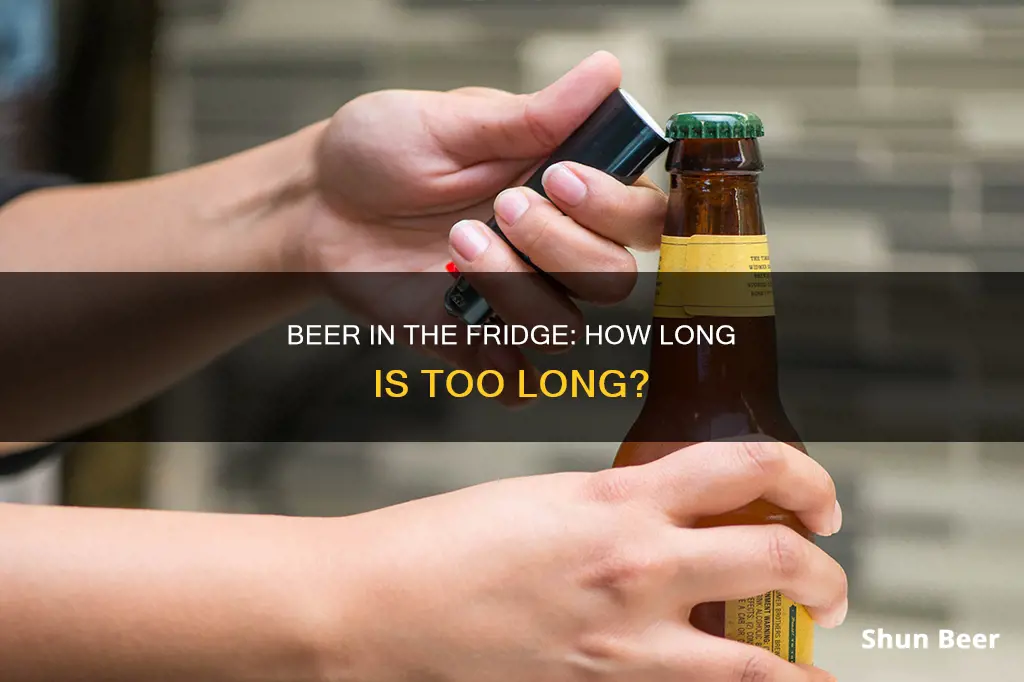
Beer is a delicate beverage, and its quality can deteriorate quickly once the bottle is opened. The clock starts ticking on a beer's freshness as soon as it's exposed to the elements, and even when continuously refrigerated, an opened beer will generally only stay at its best quality for about a day.
So, can you drink a beer that's been open in the fridge for a week? The answer is... maybe. While it's unlikely to pose any health risks, the flavour will have significantly deteriorated, and the beer will be flat. However, if you're using the beer for cooking, it should be fine, as long as it's kept airtight.
| Characteristics | Values |
|---|---|
| Beer's shelf life when opened | 1-2 days for optimal taste and quality |
| Beer's shelf life when unopened | 4-6 months when stored at room temperature |
| Beer's shelf life when opened and refrigerated | 1 week |
| Beer's shelf life when refrigerated and covered | 3-4 months |
| Beer's shelf life when refrigerated and uncovered | 1 day |
| Beer's shelf life when exposed to sunlight | 1 day |
| Factors that affect beer's shelf life | Temperature, UV rays, oxidation, carbonation, bacteria and other microbes |
| How to extend beer's shelf life | Store in a cool, dry place, limit exposure to sunlight, seal tightly, avoid temperature fluctuations |
| Signs of spoilage | Unpleasant odour, strange taste, cloudiness, mould growth |

Beer's shelf life
Beer does expire, but it doesn't become unsafe to drink. If you drink expired beer, you will likely experience unpleasant tastes and aromas. You won't get sick, but you probably won't enjoy it.
The shelf life of beer depends on many factors, including the type of beer, the container, the time of bottling, and how it is stored.
Beer Shelf Life by Container
Kegs are best used sooner rather than later. Keep them in a cool, dry space, away from other foods, and avoid moving them around too much.
Packaged beer is best stored in a dry, cool place, but not freezing. Temperatures between 45 and 55 degrees Fahrenheit are optimal. Bottles should be kept upright. Canned or bottled beer can be kept just below room temperature or just above typical refrigerator temperatures. Refrigerated unopened beer will remain at its best quality for up to eight months. Unopened beer kept at room temperature will stay at its best quality for up to six months.
Growlers are best stored upright in a cool, dark space. Once opened, the beer will stay fresh for up to 36 hours.
Beer Shelf Life by Type
The variety or style of beer also plays a role in its shelf life.
- Light beers, such as pale ales, wheat beers, lagers, and IPAs, are usually lower in alcohol, so they should be drunk within three months of packaging. IPAs can last up to 12 months, but the quality will decrease after a few months.
- Wheat beers and brown ales are best enjoyed within four months.
- Heavier beers like stouts and porters have a longer shelf life of about six months.
- Barrel-aged beers, such as sour ales and imperial beers, tend to have higher alcohol content and need time to reach their peak flavour. These beers can benefit from longer storage.
Beer Shelf Life Once Opened
Once a bottle of beer is opened, it is only fresh for 1-2 days. You can still drink it after three days, but the taste will not be as pleasant. Opened beer should be refrigerated and tightly covered to maximise its shelf life.
Factors Affecting Beer Shelf Life
Temperature
Temperature plays a pivotal role in determining a beer's shelf life. Beer stored in a warm place above room temperature will lose its freshness quickly. Storing beer in the refrigerator prolongs its freshness. Ideally, beer should be stored at typical refrigerator conditions—35°F and 46°F. If you don't have a fridge, choose a cool, dark place like a pantry or cellar.
Sunlight
Sunlight, especially UV rays, can cause beer to develop a skunky odour and taste. Beer stored in clear or green bottles is particularly susceptible to this. Brown bottles offer better protection, and cans completely shield beer from light.
Oxygen
Oxygen exposure can cause oxidation, degrading the beverage's flavour and changing its colour. Bottled beer is more susceptible to oxygen exposure than canned beer. Store beer upright to reduce the surface area in contact with oxygen.
Bacteria
Bacteria is an unusual culprit as it is difficult for it to survive in beer due to its high alcohol content, which acts as a natural preservative. However, if bacteria gets into the beer, it will eat away at it. Refrigerating beer can increase its shelf life by slowing the life cycle of microbes such as yeast.
Beer and Sore Throats: Is It Safe to Drink?
You may want to see also

Beer's flavour
Beer is a beloved beverage for many, but its flavour profile is delicate and can be easily affected by a number of factors. The flavour of beer can change even when stored unopened, but once opened, its flavour can deteriorate rapidly.
Oxygen Exposure
Oxygen exposure is a significant factor in altering the flavour of beer. When beer comes into contact with oxygen, it can cause oxidation, which degrades the beverage's flavour and changes its colour. Beer that has been left open for too long may develop strange, metallic, sour, or cardboard-like flavours, often resulting from bacterial contamination or extended exposure to oxygen.
Temperature
Temperature plays a critical role in preserving the flavour of beer. Beer stored in warm places above room temperature will lose its freshness quickly. Refrigeration is ideal for prolonging the beer's flavour, with the recommended temperature range being between 35°F and 46°F.
UV Rays
Sunlight is another enemy of beer's flavour. The sun's rays penetrate bottles, triggering a chemical reaction that breaks down its taste components, causing flavour deterioration. Beers like India Pale Ales and other light beers are particularly susceptible to this, with their best consumption period being within three months of packaging.
Time
Time is also a factor in beer flavour deterioration. Beer that has been opened is generally only fresh for 1-2 days, after which its flavour will be far from pleasant. Beer that is continuously refrigerated will stay at its best quality for about a day.
Other Factors
Other factors that can impact beer flavour include humidity, exposure to other food odours, and the type of container it is stored in. Beer stored in cans will have a longer shelf life than beer in bottles due to reduced oxygen exposure.
In summary, beer is a perishable beverage, and its flavour is highly susceptible to changes in its environment. To maintain its optimal flavour, beer should be consumed promptly after opening, stored in a cool, dark place, and kept in an airtight container.
Beer Die: A Fun Guide to the Game and its Rules
You may want to see also

Beer's quality
Beer is a fragile drink, and its quality can deteriorate quickly once the bottle or can has been opened. Exposure to oxygen causes oxidation, which affects the beverage's flavour and colour. Beer also loses its carbonation and goes flat.
The shelf life of beer depends on several factors, including the type of beer, alcohol content, and storage conditions. Generally, an unopened beer can last up to six months, while an opened beer can last up to a few days to a week in the fridge.
To ensure the best quality, beer should be stored in a cool, dry place, ideally at refrigerator temperatures of 35°F to 46°F. Exposure to UV rays from sunlight can also cause flavour deterioration, so it is best to store beer in dark bottles or cans and keep it away from light.
Once a beer is opened, it is important to seal it tightly to minimise oxygen exposure and slow down oxidation. Storing beer upright also helps reduce the surface area exposed to oxygen. Additionally, avoiding temperature fluctuations is crucial, as rapid changes can negatively impact the brew's quality and taste.
While beer can be safely consumed after its "Best Before" date, its flavour and quality may decline. Beer is considered flat when its carbonation level rises, resulting in a lack of distinctive bitterness and sharpness. Flat beer may still be drinkable, but it will have an unpleasant flavour.
If beer is left out in the open for too long, it can be contaminated by bacteria and other microbes, posing safety risks. Therefore, it is recommended to consume open beer within one to two days for optimal flavour or within a week to avoid spoilage.
To extend the shelf life of open beer, it can be stored in airtight containers, such as beverage canisters or recycled plastic soda bottles, and chilled to slow down oxidation. Adding a few drops of sterile beer salts can also help create an environment where germs cannot thrive.
Drinking Beer in an Uber: Is it Allowed?
You may want to see also

Beer's storage
Beer storage is a complex topic, with many factors influencing how long a beer will last. These factors include the type of beer, the container, the time of bottling, and the beer's variant.
Temperature
The ideal temperature for storing beer depends on the type of beer. For strong beers like barley wines and strong ales, the ideal storage temperature is around 24°F (-4.4°C). For standard ales, such as pale ales, IPAs, and stouts, the ideal temperature is 50-55°F (10-12°C). Lighter beers, such as lagers, pilsners, and wheat beers, should be stored at 35-46°F (2-7°C). It is important to avoid exposing beer to temperature fluctuations, as this can negatively impact its quality and taste.
Container
The type of container also plays a role in beer storage. Beer cans and bottles should be stored upright in a cool, dry place, with temperatures above freezing. Growlers, which are typically made of brown glass, should be sealed properly and stored in a cool place. Beer kegs should be stored in a dark, cool place, with consistent temperatures, and maintained at a pressure of 10-12 psi. Corked beer should also be stored upright and consumed within a year and a half of bottling, as it tends to mature faster than other types of beer.
Light Exposure
Light exposure, especially to UV rays, can negatively impact beer's quality and taste. Beer stored in clear bottles is most susceptible to skunking, while brown bottles offer more protection. Green bottles offer some protection but are not as effective as brown ones. Storing beer in a dark place, such as a pantry, cellar, or basement, can help prevent light exposure and prolong its shelf life.
Oxygen Exposure
Oxygen exposure can cause oxidation, degrading the flavour and colour of the beer. Storing beer upright can help minimise the surface area exposed to oxygen and slow down the oxidation process. Sealing beer bottles or cans after opening can also help prevent oxygen exposure.
Time
The shelf life of beer depends on various factors, including the type of beer, storage conditions, and whether it has been opened. Unopened beer stored in a cool, dry place can last for several months. However, once opened, beer should be consumed within 1-2 days to enjoy its best flavour. Refrigeration can help slow down the degradation process, but even with proper storage, opened beer will eventually lose its carbonation, flavour, and freshness.
Old Beer: Drink or Dump?
You may want to see also

Beer's safety
Beer Safety
The precise answer depends on storage conditions. To maximize the shelf life of opened beer, keep it refrigerated and covered. Beer that has been continuously refrigerated will generally stay at best quality for about a day. However, you can still drink it after three days without exposing yourself to any health hazards.
Beer's freshness starts to deteriorate as soon as it is exposed to the elements. Generally, a sealed beer can stay at its optimal quality for about 4 to 6 months when stored at room temperature. However, if you open a beer bottle, it’s only fresh for 1-2 days, so you should drink it within that period to enjoy its best flavor.
Temperature plays a pivotal role in determining an open beer’s shelf life. If you store it in a warm place above room temperature, its freshness will decrease quickly. On the other hand, storing it in your refrigerator prolongs its freshness. Ideally, you should store beer at typical refrigerator conditions—35°F and 46°F.
If you don’t have a fridge, choose a cool, dark place that is undisturbed by regular movements, such as a pantry or cellar. Beer will likely last longer in these areas as the temperatures are lower.
Like any other product, spoiled beer develops a strange smell. If you detect any unpleasant odor, such as skunk or urine, it has already gone wrong, and you should not drink it. The presence of off odors could indicate the growth of bacteria or other microorganisms in the beer, meaning you can get sick if consumed.
Strange beer tastes are also a clear sign the beverage has expired. These are often metallic, sour, or cardboard-like flavors, usually resulting from bacterial contamination or extended exposure to oxygen.
Another indication of spoilage or bacterial contamination in beer is cloudiness. When bacteria are present, they can cause proteins and other compounds to clump together, leading to a cloudy appearance in the beverage. The haze in beer is often accompanied by strange tastes or off odors.
- Find the perfect storage spot: Store beer in a cool, dry place with temperatures between 35 and 55 degrees Fahrenheit (2 to 13 degrees Celsius). Avoid areas prone to temperature fluctuations, such as near windows or heating vents.
- Keep your beer away from light: Exposure to UV rays is one of the fastest ways to ensure your beer goes bad, even before its expiry date.
- Keep the beer sealed and upright: Ensure you properly seal your beer bottles or cans after opening them. This helps prevent oxygen exposure, which can cause the beverage to go bad faster.
- Avoid temperature fluctuations: Do not expose your beer to temperature fluctuations to enable it to last longer. Rapid temperature changes can negatively impact the brew’s quality and taste.
Beer and Bone Grafts: What You Need to Know
You may want to see also
Frequently asked questions
No, it is not recommended to drink open beer that has been left in the fridge for a week. Beer is best consumed within 1-2 days of being opened, as its flavour and quality deteriorate quickly. After a week, the beer will likely be flat, and there is a risk of bacterial contamination.
Open beer will stay at its best quality for about 1 day in the refrigerator. After that, it will start to lose carbonation, flavour, and freshness. However, it can still be consumed within 3-4 days without any health risks.
To extend the shelf life of open beer, store it in an airtight container, such as a growler or a recycled plastic soda bottle, and keep it refrigerated. You can also add a few drops of sterile beer salts to inhibit bacterial growth.
Open beer that has gone bad will exhibit signs such as an unpleasant flavour, a musty or sour smell, cloudiness, or visible mould. If the beer shows any of these signs, it should be discarded.







